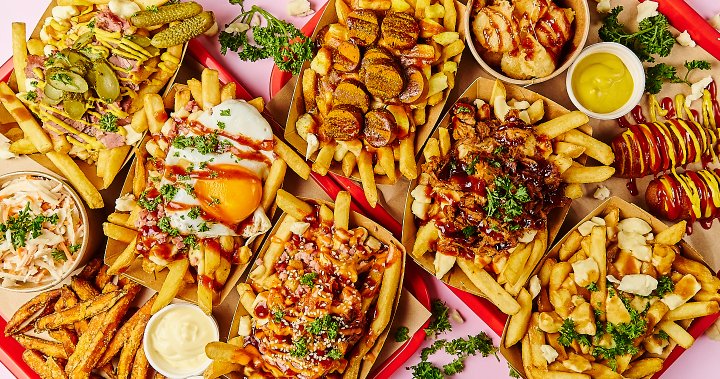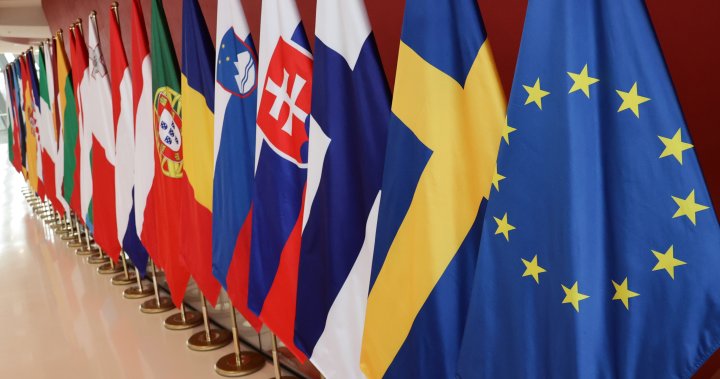Culinary ‘weapons’: How Canada plans to win over Germans, one bite at a time – Montreal

Canada is generally known for being a country with nice people and good manners. It’s also considered a political ally of Germany.
But Canucks are mounting a massive offensive in “the country of poets and thinkers” — all in the most polite, Canadian way, of course: through food.
Canada is investing in developing its culinary diplomacy in Germany. The Taste of Canada campaign, which started during the COVID-19 pandemic, aims to hook Germans on the country through their stomachs.
“Our new Taste of Canada campaign is focused on online trade primarily,” said Nora Düpmann, a senior trade commissioner for Agrifood and Agriculture Canada based out of the Canadian Consulate in Dusseldorf, Germany.
“All of the trade fairs had been cancelled. So we had a bit of money available and said, ‘What can we do?”
Enter food diplomacy, a way of bringing people together through the culinary aspect of a culture.
“It’s a way to give the country an image and to really advocate a culture, a people and its culinary representation in other countries,” said Lena Olesch, also a trade commissioner.
There is a lot of diplomacy to deploy in Germany in that aspect.
According to a German food consumer study commissioned by AgriFood Canada and published in 2012, Canadian food is virtually unknown, but Germans have a genuine openness and enthusiasm to learn more.
“It’s a blind spot on the map but a positive image is generally associated with Canada,” said Nora Düpmann, also a trade commissioner. “We always ensure that at events that we have at the embassy or missions or even at trade shows, that we serve Canadian foods to the extent that is possible.”
But that is not the only thing Canada is doing.
The trade commission is branching out by enlisting insider help and handing them Canadian culinary “weapons.”
Culinary weapon #1: poutine
Poutine is the province of Quebec’s most iconic and most peculiar dish.
For Berliner Holger Böckner, poutine tastes so good, it dramatically changed his life.
Böckner first encountered poutine in 2007 when he was working in the movie industry and visited Montreal.
“I got introduced to poutine and fell in love with the food,” Böckner said.
Years later, he says he yearned for the messy snack so much, he made a radical move.
“I left the movie industry world in Germany and I started my mission to bring real poutine to the German people,” Böckner said.
Holger Böckner at an event in Berlin promoting Canadian delicacies.
Food Embassy
That’s how the Food Embassy was born, an agency for culinary diplomacy and communications.

Get daily National news
Get the day’s top news, political, economic, and current affairs headlines, delivered to your inbox once a day.
Böckner’s longing is understandable when you compare “the real deal” to the options available in Berlin.
The restaurant chain Frittenwerk serves the Canadian delicacy.
On its menu, the “Montreal classic” includes “creamy mushroom sauce, tenderly melting mozzarella cheese and sliced radishes.”
Any Quebecer or poutine connoisseur would flinch at the sight of radishes on their “classic poutine.” Mozzarella? It doesn’t squeak. “Sacrilège!”

It’s something staff working at the Canadian Trade Commissioner Service in Germany know very well.
Böckner’s Food Embassy has been hired by the Canadian government to help with the Taste of Canada campaign in German-speaking countries: Germany, Switzerland and Austria.
Together, they’ve led several projects, including the creation of Berlin’s Canada Day celebrations, in association with the German Canadian Association, where, of course, the “real” poutine was served.
Böckner also opened The Poutine Kitchen, what he bills as Germany’s first real poutine restaurant, “offering genuine cheese curds from Quebec for the first time in Germany.”
An ecosystem
To obtain real curds, Böckner returned to Canada on a mission to find a dairy producer who could supply the famous fromage.
Paul-André Veilleux, deputy general manager at Coaticook Dairy, jumped on board.
“We are happy to be a part of this, to promote the real Canadian poutine with the real cheese curds,” Veilleux said. “Of course, that opens doors.”
Veilleux says the biggest challenge is trying to preserve the cheese’s freshness, which leads to its famous texture.
“We try to keep the squeakiness, the ‘squish squish,’ the best that we can, so we need to freeze the product,” Veilleux explained.
While The Poutine Kitchen was forced to close due to the impacts of the coronavirus pandemic, it evolved into an online shop where Germans can buy poutine gravy and the famous squeaky cheese.
The Poutine Kitchen Restaurant in Berlin.
Food Embassy
Plans to reopen the restaurant under new ownership in November are underway, Böckner says.
Canada Beef also participates in Taste of Canada; another recent initiative of the campaign was the publication of a Canada-themed cookbook that explores Canadian cuisine.
Böckner tapped Berlin-based Canadian chef Geneviève Pilon to create recipes for Germans with Canadian ingredients. One of those recipes was with Canadian beef and maple syrup and was published in a booklet.
“You really have to choose ingredients that they are familiar with. Germans have this great saying that is ‘What the farmer doesn’t know, he doesn’t eat,’” said Pilon, the culinary director for the Food Embassy.
“The idea is to take a recipe which they know, recipes that are classic here and then bring a touch of Canadian ingredients into it.”
Pilon says she would replace honey with maple syrup, for example.
“Little touches here and there,” she said.
Pilon explains that Germans’ attitude towards Canadian food has evolved in the past 10 years.
A decade ago, Pilon would pack her suitcase with cans of maple syrup to bring to her German friends.
Their reaction puzzled her.
“At the beginning people would tell me, ‘Oh no, I don’t like maple syrup, it’s too sweet for me,’” she said. “I was always surprised because you see them eating honey, you see them eating chocolate … it’s the association that maple syrup was unhealthy.”
Pilon says things started changing when the vegan scene grew.
Germans started linking vegan with healthy and because honey isn’t vegan, they turned to maple syrup.
“You started seeing it in the organic markets more and more,” she says.
It can also be found in the shelves of grocery store chains, such as Edeka or Lidl.
Germany is one of the biggest consumers of maple syrup in the world.
According to Statistics Canada, Germany is Canada’s second largest market for maple syrup after the United States.
In 2023, Germany imported 4,755,689 kilograms of maple syrup and products, an equivalent of $47.7 million. It represents a 7.8 per cent share of the total exports of maple syrup.
Germany, which in 2023 had the largest economy in the European Union and the third largest in the world, is a key economic partner for Canada.
Expanding horizons
While the golden liquid is Canada’s flagship product in Germany, the trade commission is expanding culinary horizons and promoting other products.
According to Olesch, it’s not an easy task.
“Germany is also a very price-sensitive market,” Olesch said. “Canadian products aren’t in general the cheapest ones. So we are working in a premium high-price range.”
Quebec’s Cirka Gin and Sortilege Maple Whisky, along with Niagara wines from Pillitteri Estates Winery and oddly enough, Moosehead beer are some other products that fit the bill.
A small taste to open up German’s appetite for Canada.








